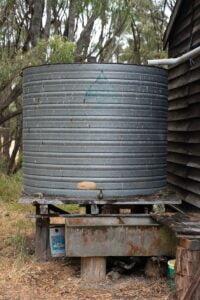Rain water harvesting is a way to save water and make it easier for cities to keep up with water needs. In today’s world, where water shortages are becoming a bigger problem, it’s important to use sustainable methods like collecting rainwater. In this detailed guide, we’ll go over the different parts of rainwater harvesting and look at how this environmentally friendly method can be used effectively.
Now, let’s explore each of these components in detail to understand how rain water harvesting can be seamlessly integrated into your water management strategy.
1. The Importance of Rain Water Harvesting

Rainwater harvesting is a sustainable method of collecting and storing rainwater for uses like watering plants, flushing toilets, and even drinking. It reduces the need for water from traditional sources, stops flooding, and fills up groundwater aquifers.
1.1 Purpose of Rain water Harvesting Components
To build a rain water harvesting system that works, it’s important to know the key parts. Each part of the system is very important to how it works as a whole. In this article, we’ll talk about these parts and what they mean for collecting rainwater.
ABS Polymer: A Comprehensive Look at Its Properties and Environmental Impact
2. Catchment Surface
The catchment surface is where rainwater is collected before it is channeled into the harvesting system. Common catchment surfaces include:
2.1 Rooftop Collection
Rooftops are excellent catchment surfaces due to their large surface area. Rainwater can be collected from residential, commercial, or industrial roofs.
2.2 Paved Surfaces
In some cases, paved surfaces like driveways or courtyards can serve as catchment areas. Proper drainage systems are required to collect and direct the water.
3. Conveyance System
Once rainwater is collected on the catchment surface, it needs to be transported to the storage tanks. This is where the conveyance system comes into play.
3.1 Gutters and Downspouts
Gutters and downspouts are essential for collecting rainwater from rooftops and guiding it into pipes or channels.
3.2 Pipes and Channels
Pipes and channels transport rainwater from the catchment surface to the storage tanks. They should be designed to minimize water loss and ensure efficient flow.
4. Storage Tanks
Storage tanks are crucial components of rainwater harvesting systems, where rainwater is stored for later use.
4.1 Types of Storage Tanks
There are various types of storage tanks, including aboveground and underground tanks. The choice depends on available space and specific requirements.
4.2 Tank Sizing and Placement
Proper sizing and placement of storage tanks are vital to ensure an adequate supply of harvested rainwater. Factors like demand and climate must be considered.
5. Filtration System
Before rainwater enters the storage tank, it must be filtered to remove debris and contaminants.
5.1 First Flush Diverters
First flush diverters are devices that divert the initial rainwater flow, which may contain pollutants, away from the storage tank.
5.2 Filters and Screens
Filters and screens further purify rainwater by removing leaves, debris, and particles, ensuring the stored water is clean and safe.
6. Treatment and Disinfection
To make harvested rainwater suitable for various uses, treatment and disinfection processes are often necessary.
6.1 UV Sterilization
UV sterilization is an effective method for disinfecting rainwater, killing harmful microorganisms without the use of chemicals.
6.2 Chemical Treatment
In some cases, chemical treatments like chlorination may be required to ensure the water’s safety.
7. Distribution System
Once rainwater is treated, it can be distributed for various purposes.
7.1 Gravity Flow Systems
Gravity flow systems use the natural downward flow of water to distribute it to desired locations.
7.2 Pumped Systems
In areas with elevation challenges, pumped systems are used to transport rainwater to different parts of a building or landscape.
8. Maintenance and Monitoring
Regular maintenance and monitoring are essential to keep the rainwater harvesting system functioning optimally.
8.1 Regular Inspection
Inspecting components, including filters, tanks, and pipes, ensures there are no leaks or blockages.
8.2 Cleaning and Repairs
Cleaning and repairing any damaged components are crucial for the longevity of the system.
9. Benefits of Rainwater Harvesting
9.1 Environmental Benefits
Rainwater harvesting reduces the strain on natural water sources, conserving water and protecting ecosystems.
9.2 Economic Benefits
Harvesting rainwater can lead to significant cost savings on water bills and irrigation expenses.
10. Challenges and Considerations
10.1 Water Quality
Maintaining water quality is essential to ensure that harvested rainwater is safe for various uses.
10.2 Legal and Regulatory Considerations
Understanding local regulations and obtaining necessary permits are crucial when implementing rainwater harvesting systems.
11. Case Studies
Explore successful rainwater harvesting projects to gain insights into real-world applications of this eco-friendly practice.
12. Future Trends
Discover the latest technological advancements and how rainwater harvesting is being integrated into smart homes and sustainable communities.
13. How to Get Started
Planning your rainwater harvesting system involves assessing your needs, calculating water potential, and designing a system that suits your requirements.
14. Disadvantages of rain water harvesting
Certainly, here are some disadvantages of rain water harvesting:
- Initial Cost: Installing a rain water harvesting system can be expensive. It involves purchasing and setting up various components such as storage tanks, filters, and conveyance systems. The upfront investment may deter some individuals or organizations.
- Space Requirements: Large storage tanks and collection surfaces may require ample space. In urban areas with limited space, finding suitable locations for these components can be challenging.
- Weather Dependency: Rain water harvesting is heavily reliant on weather conditions. In regions with irregular or insufficient rainfall, there may be periods of water scarcity, making the system less reliable.
- Water Quality: The quality of harvested rainwater can be variable, especially if the catchment surface is contaminated or if proper filtration and treatment are not in place. This can affect its usability for certain applications, such as drinking water.
- Maintenance Demands: Rain water harvesting systems require regular maintenance, including cleaning filters, inspecting pipes, and ensuring the integrity of storage tanks. Neglecting maintenance can lead to system inefficiencies and potential contamination.
- Initial Pollutant Flush: The first rain after a dry spell can contain pollutants from the catchment surface, such as dust, leaves, and bird droppings. This “first flush” may not be suitable for use, requiring diversion or filtration.
- Freezing Concerns: In cold climates, stored rainwater can freeze during winter, potentially damaging the storage tanks and pipes. Special provisions, like insulation and heating, may be needed in such areas.
- Regulatory Hurdles: Depending on your location, there may be local regulations and permitting requirements for rainwater harvesting systems. Compliance with these regulations can add complexity and cost to the installation process.
- Limited Supply for Large-Scale Needs: Rainwater harvesting is typically more suitable for individual households, small businesses, or specific applications. It may not provide a sufficient supply for larger-scale water demands, such as industrial processes or agriculture.
- System Complexity: Designing and maintaining an effective rain water harvesting system can be complex. It requires knowledge of various components, their interaction, and water treatment methods. Improperly designed systems may not yield the expected benefits.
15. Conclusion
Rainwater harvesting is a sustainable and environmentally friendly way to handle water. People and communities can help save water and make the future greener by understanding the different parts and putting them to good use.
In the end, collecting rainwater is a choice that is both good for the environment and useful. It has a lot of benefits, like lowering water bills and being better for the environment. As we move towards a more sustainable future, we should include rainwater harvesting in our plans for how to handle water.
Feel free to learn more about collecting rainwater, and don’t be afraid to get in touch if you have any questions or need help setting up your own system. Together, we can make a big difference in saving water and making the world a better place.
16. FAQs (Frequently Asked Questions)
What is the ideal catchment surface for rainwater harvesting?
The ideal catchment surface depends on your specific needs and available space. Rooftops are commonly used, but other paved surfaces can also be utilized.
Can rain water harvesting be used for large-scale water supply?
Yes, rainwater harvesting can be scaled up to meet larger water supply needs, especially in commercial and industrial settings.
Is rainwater safe for drinking after treatment?
With proper treatment and disinfection, rainwater can be made safe for drinking. However, it’s essential to follow guidelines and regulations.
Are there any government incentives for rain water harvesting?
Some regions offer incentives, tax benefits, or rebates for implementing rainwater harvesting systems. Check with local authorities for information.
What are the maintenance requirements for a rain water harvesting system?
Regular inspection, cleaning, and timely repairs are essential to maintain the efficiency and longevity of a rainwater harvesting system.
N.B. Do not use this type of stored water for drinking, Cooking etc., without a proper quality checkup.







